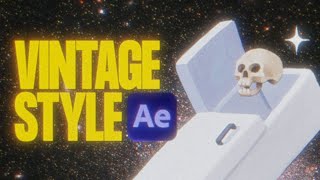
Introduction: Retro animation holds a timeless appeal, evoking nostalgia for bygone eras while infusing a sense of charm and creativity into modern projects. Whether you’re aiming to recreate the aesthetics of classic cartoons, vintage advertisements, or 8-bit video games, mastering retro animation techniques in Adobe After Effects can help you achieve distinctive and visually captivating results. In this extensive guide, we’ll explore the step-by-step process of creating retro animation in After Effects, covering everything from basic setup to advanced techniques, ensuring that you can infuse your projects with retro flair and personality.
Understanding Retro Animation: Retro animation refers to the distinctive visual style and techniques associated with past decades, such as the 1950s, 1960s, 1970s, and 1980s. This aesthetic often incorporates elements such as vibrant colors, hand-drawn illustrations, pixel art, analog effects, and nostalgic themes. By embracing retro animation techniques, you can evoke a sense of nostalgia, whimsy, and authenticity in your projects, capturing the essence of a bygone era while adding a modern twist.
Basic Setup: To create retro animation in Adobe After Effects, follow these steps:
- Create a New Composition: Launch After Effects and create a new composition by selecting “Composition” > “New Composition” from the menu. Set the desired dimensions, frame rate, and duration for your composition.
- Import Assets: Gather or create assets such as images, illustrations, and audio files that evoke the retro aesthetic you want to achieve. Import these assets into your After Effects project for use in your animation.
- Arrange Layers: Arrange your assets in the composition timeline, organizing them into layers for easy manipulation and animation. Consider the layering order and hierarchy to ensure that elements are properly positioned within the composition.
Creating Retro Effects: Once you’ve set up your composition, you can begin applying retro effects and techniques to your animation. Here are some techniques for creating retro animation in After Effects:
- Hand-Drawn Animation: Emulate the look of hand-drawn animation by creating illustrations or characters using drawing tablets or vector graphics software. Import these assets into After Effects and animate them using keyframe animation techniques.
- Vintage Filters: Apply vintage filters or color grading effects to your footage or illustrations to achieve a retro look. Experiment with color presets, film grain overlays, and vignetting effects to add authenticity to your animation.
- Analog Glitches: Simulate analog glitches and distortions to create a retro-futuristic vibe. Use effects such as Bad TV, Data Glitch, or Twitch to add flickering, static, and distortion effects to your animation.
- Pixel Art Animation: Create pixel art assets using pixel art software or by hand-drawing pixel art sprites. Import these assets into After Effects and animate them using keyframe animation or puppet tools to create retro-inspired pixel art animations.
- Retro Typography: Use vintage typography and lettering styles to add retro flair to your text animations. Experiment with retro fonts, typography animations, and text effects to create dynamic and eye-catching retro typography animations.
Advanced Techniques: Once you’re comfortable with the basic setup and retro effects, you can explore advanced techniques to enhance your retro animation:
- Character Rigging: Rig character animations using the Duik Bassel or RubberHose plugins to create dynamic and expressive character animations. Utilize inverse kinematics (IK) and puppet pins to rig characters for smooth and natural movement.
- Frame-by-Frame Animation: Embrace frame-by-frame animation techniques to create fluid and expressive motion. Use the Paint Brush tool or shape layers to draw and animate each frame individually, adding a handcrafted touch to your animation.
- Parallax Scrolling: Create parallax scrolling effects to add depth and dimensionality to your animation. Animate multiple layers at different speeds to simulate the effect of foreground and background movement, adding visual interest and immersion.
- Audio Synchronization: Sync your animation with retro-inspired sound effects or music to enhance the overall impact. Choose audio cues that complement the visual style and theme of your animation, creating a cohesive and immersive experience for the viewer.
- Dynamic Transitions: Create dynamic transitions between scenes or shots to keep the viewer engaged. Use effects such as wipes, fades, or animated masks to transition between elements smoothly, adding polish and professionalism to your animation.
Practical Applications: Retro animation can be applied to a variety of creative projects across different industries. Here are some practical applications:
- Motion Graphics: Enhance motion graphics projects with retro-inspired animations and visual effects. Use retro typography, vintage illustrations, and analog effects to create dynamic and engaging motion graphics.
- Title Sequences: Create captivating title sequences with retro-inspired typography and animations. Use animated text, vintage filters, and dynamic transitions to set the mood and tone for your video projects.
- Advertising: Produce nostalgic advertisements or promotional videos with retro animation techniques. Capture the attention of your audience with vibrant colors, catchy jingles, and memorable characters that evoke the spirit of past decades.
- Educational Content: Create educational videos or tutorials with retro-inspired animations. Use animated characters, retro graphics, and engaging visuals to make learning fun and engaging for your audience.
- Indie Games: Develop indie games with retro-inspired pixel art animations. Create charming characters, immersive environments, and dynamic animations that pay homage to classic video games and retro gaming culture.
Conclusion: Retro animation in Adobe After Effects offers a creative and versatile tool for evoking nostalgia, charm, and authenticity in your projects. By mastering the basic setup, exploring retro effects, and experimenting with advanced techniques, you can infuse your animations with retro flair and personality that captivate your audience. Whether you’re a seasoned animator or a newcomer to After Effects, retro animation provides endless possibilities for creative expression and storytelling. So, dive in, experiment, and unleash the full creative potential of retro animation in Adobe After Effects.